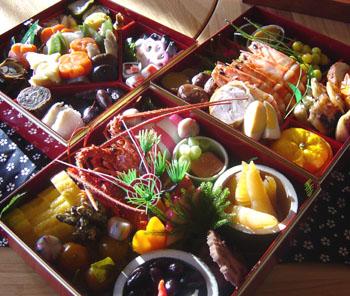- 12/14/2010
- 02/27/2021
Osechi – New Years Feast in Japan
It may be strange to think about new years day when it’s not even Christmas yet.? But not if you are making reservation for Osechi (???膀?). Osechi is a traditional Japanese New Year feast. The tradition started in the Heian Period (綛喝?????篁?, 794-1185). Osechi?is?usually put into?special boxes called Jubako (???膊?), which resemble?bento boxes, only more flamboyant. Like bento boxes, jubako are often kept stacked before and after use. The dishes that make up Osechi each have a special meaning celebrating the New Year. Some examples are: Kazunoko (??違????) Herring roe.? Kazu (???)?means “number” and ko (絖?) means “child”. ?It symbolizes a wish to be gifted with numerous children in the?coming year. Kuro-mame (藥?莟?) Black soybeans. ?Mame (莟?, beans) also means “health”, symbolizing a wish for health. Tazukuri (??遺?????) Dried sardines cooked in soy sauce.? The literal meaning of the kanji in tazukuri is “rice?field maker”, as the fish were used historically to fertilize rice fields. The symbolism is of an abundant harvest. The above three are called Iwai-zakana Sanshu (腑??????岩??腮?, three celebrational dishes).? Without these three, the new years feast would not be complete. Iwai-zakana Sanshu differs by regions.? The above are the Kanto (including Tokyo) style. Traditionally, Osechi is […]
